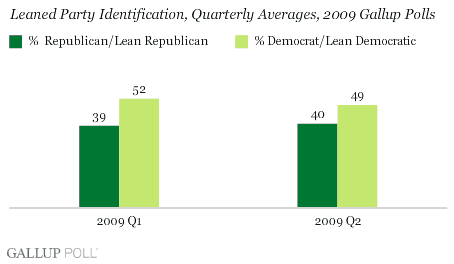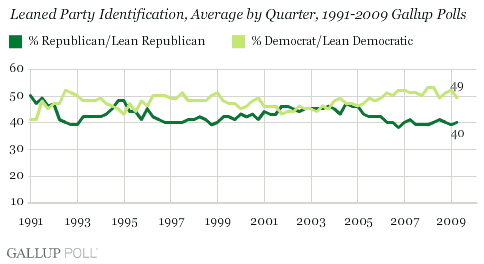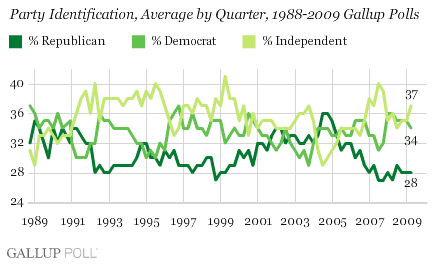PRINCETON, NJ -- The Democratic Party continues to hold a solid advantage in party support over the Republican Party, as 49% of Americans interviewed in the second quarter of this year identified with or leaned to the Democratic Party, compared with 40% who did so for the Republican Party. However, that nine-point Democratic advantage is smaller than the 13-point edge Gallup measured in the first quarter of the year.

The declining Democratic advantage is due more to a drop in Democratic support (from 52% to 49%) than to an increase in Republican support (from 39% to 40%).
The lessening Democratic advantage may to some degree reflect a return to more typical party support levels, because the 13-point Democratic edge from the first quarter is on the high end of what Gallup has found since it began tracking this measure of party identification in 1991.
Even with the decline, Democrats continue to hold a solid advantage in leaned party identification, something they have enjoyed since the second quarter of 2005. Democrats have led the Republicans on this measure by at least 10 points for 11 of the last 13 quarters.

Gallup's basic measure of party identification -- which does not take into account the partisan leanings of independents -- shows a slight decline in Democratic Party identification in the first quarter of 2009 (from 35% to 34%) and a slight increase in independent identification (from 35% to 37%). There has been no change in Republican identification, which at 28% remains on the low end of what Gallup has measured for the past two decades.

The fact that Democrats hold a six-point advantage on initial party identification compared with a larger nine-point lead on leaned party identification indicates that independents are currently a little more likely to lean to the Democratic Party than to the Republican Party.
Implications
Gallup polling shows a slight dip in Democratic support in the most recent quarter. However, the Democrats had such a large cushion that even with the drop, they maintain a sizable advantage over the Republican Party.
The data indicate also that, although the party gap may be shrinking, the Republicans have not made any significant gains of their own in recent months. Their support levels remain on the low end of what Gallup has measured for the past two decades.
Survey Methods
Results are based on averages from five Gallup surveys conducted between April and June 2009, each consisting of approximately 1,000 interviews with national adults, aged 18 and older. For results based on the total sample of national adults, one can say with 95% confidence that the maximum margin of sampling error is ±1 percentage point.
Interviews are conducted with respondents on land-line telephones (for respondents with a land-line telephone) and cellular phones (for respondents who are cell-phone only).
In addition to sampling error, question wording and practical difficulties in conducting surveys can introduce error or bias into the findings of public opinion polls.
